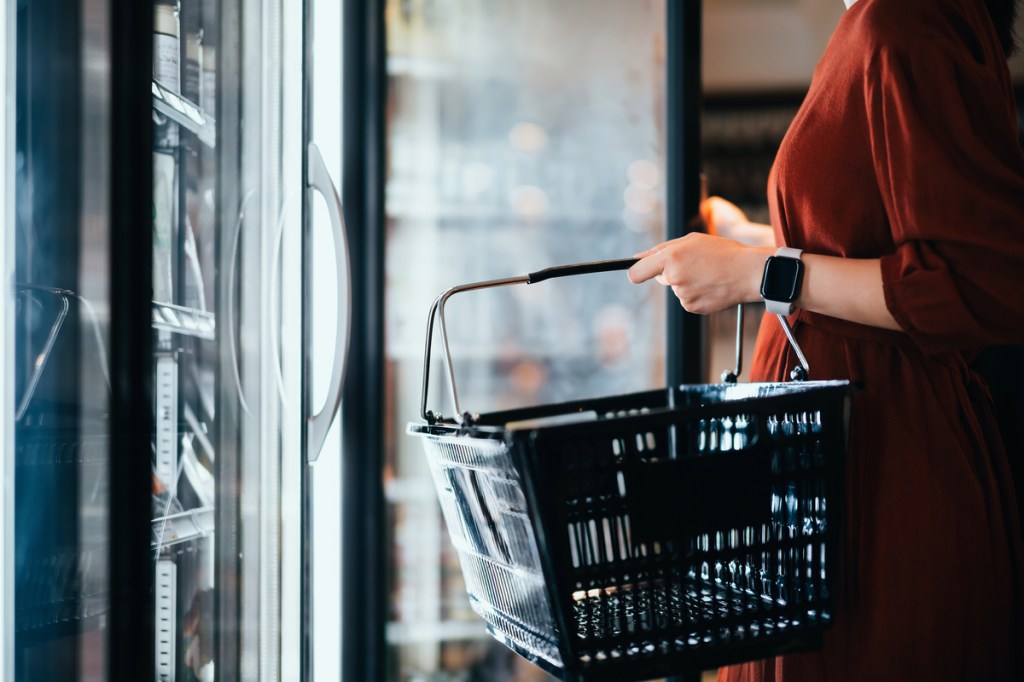Key Drivers of Online Grocery Growth
By 2040, a staggering 95% of purchases are projected to be made online.1 Yet, total online food sales in the past year are only 10.7% of the dollar volume of in-store sales.2 With so much room to grow, it makes sense that online grocery sales are growing at a fast pace. That’s because the growth of online grocery shopping is fueled by several key drivers that have significantly reshaped consumer behavior and the retail landscape. Among these drivers, convenience remains at the forefront, with more consumers opting for the ease of having groceries delivered directly to their doorsteps. The ability to shop from anywhere at any time, coupled with time-saving features like recurring orders and personalized recommendations, has made online grocery shopping an attractive option for busy households.
Additionally, technological advancements have played a critical role in accelerating this growth. Innovations such as mobile apps, voice-activated shopping, and artificial intelligence are enhancing the user experience, making it more seamless and intuitive. These technologies are not only simplifying the shopping process but also providing consumers with more tailored and efficient services. Moreover, the competitive nature of the market has led to better pricing, wider product availability, and improved delivery options, further driving the adoption of online grocery shopping.
Emerging Online Grocery Trends
The online grocery landscape is rapidly evolving, with several key trends emerging that are shaping how consumers shop for their groceries. In fact, in-store Food sales only grew +0.9% in the last year, but online sales saw a staggering 15.1% increase.2
With that in mind, here are 3 key emerging online grocery trends helping drive this shift:
1. The Rise of Subscriptions
One of the most significant trends is the continued growth of subscription services. These services, which offer convenience through recurring deliveries of essential items, are becoming increasingly popular among busy households. Subscription models allow consumers to automate their grocery shopping, ensuring they never run out of staples like milk, eggs, or pantry items. They’re also a good way for consumers to save money, and with consumers are spending 33% more in the past 4+ years, many are seeking out ways to save.3
Additionally, these services often offer personalized recommendations based on previous purchases, making the shopping experience more tailored and efficient. As more consumers embrace this convenient way of shopping, retailers are expanding their subscription offerings to include meal kits, specialty products, and even wellness-focused items, further embedding themselves into the daily lives of their customers.
2. Consumer Demand for Sustainability and Ethics
Sustainability and ethical shopping are also becoming major drivers of consumer decisions in the online grocery space. With growing awareness of environmental issues, consumers are increasingly seeking out products that align with their values. This includes choosing items with eco-friendly packaging, supporting brands with transparent and ethical supply chains, and opting for local or organic produce. In fact, 69% of consumers state that sustainability is more important to them than it was two years ago, so many brands are capitalizing on this opportunity.4
Online grocers are responding by highlighting these attributes in their product listings, offering consumers the ability to filter products based on sustainability criteria. Moreover, some retailers are going a step further by adopting carbon-neutral delivery options and reducing waste through innovative packaging solutions. This shift towards sustainability not only meets the demands of environmentally-conscious consumers but also helps retailers differentiate themselves in a competitive market.

SPEND Z
Gen Z Changes Everything
Gen Z’s reign is upon us—NIQ’s latest report has everything you need to know to get their attention.
3. Continued Health and Wellness Growth
According to NIQ’s 2023 Consumer Outlook, 46% of consumers identified physical or mental wellness as one of their top priorities.5 As consumers become more health-conscious, there is a growing demand for online grocery options that cater to specific dietary needs and preferences. Whether it’s organic produce, gluten-free snacks, or plant-based alternatives, consumers are looking for products that support their health goals.
Online grocery platforms are leveraging this trend by offering extensive selections of health and wellness products, along with detailed nutritional information and personalized recommendations. Additionally, many platforms are incorporating features like dietary filters and wellness-related content to help consumers make informed choices. This focus on health and wellness not only enhances the shopping experience but also fosters customer loyalty by aligning with the consumers’ lifestyle aspirations.
Challenges in the Online Grocery Space
The rapid growth of the online grocery market has brought with it significant logistical and supply chain challenges. As demand for online grocery shopping continues to rise, retailers face the complex task of efficiently managing inventory, ensuring product availability, and meeting delivery expectations. The perishability of many grocery items adds an additional layer of complexity, requiring robust cold chain logistics to maintain product quality from the warehouse to the consumer’s doorstep. Delays, inventory shortages, and the inability to maintain product freshness can lead to customer dissatisfaction and lost sales. Moreover, the surge in demand for delivery services has strained last-mile logistics, making it difficult for retailers to keep pace with consumer expectations for fast and reliable delivery.
In addition to logistical hurdles, online grocery retailers are grappling with intense competition and pricing pressure. The market is becoming increasingly crowded, with established players like vying for dominance alongside smaller, niche grocers. This competition has sparked a race to the bottom in terms of pricing, as retailers strive to attract and retain customers by offering the lowest possible prices. However, maintaining profitability in such a competitive environment is challenging, especially as consumers continue to prioritize value and cost-effectiveness in their purchasing decisions. Retailers must find a delicate balance between competitive pricing and maintaining healthy profit margins, all while differentiating themselves through unique product offerings, superior customer service, and innovative shopping experiences.
Future Outlook for Online Grocery
The future of online grocery shopping is poised to be shaped by significant technological innovations that promise to enhance the consumer experience and streamline operations. Advances in artificial intelligence (AI) and machine learning are expected to play a crucial role in personalizing the shopping journey, with AI-driven algorithms providing tailored product recommendations and optimizing inventory management. In fact, a recent study from Honeywell reports 97% of retailers surveyed claim to be using AI technologies – or are in active discussions to use them – for select use cases or regions, on a large scale, or in a pilot phase.6 Moreover, the adoption of autonomous delivery vehicles and drones could revolutionize last-mile logistics, making deliveries faster and more efficient while reducing operational costs. As these technologies continue to evolve, they will not only improve convenience for shoppers but also help retailers meet the growing demand for speed and personalization.
Market expansion is another key factor that will drive the growth of online grocery in the coming years. As more consumers become comfortable with shopping for groceries online, retailers are increasingly looking to expand their reach into underserved areas and emerging markets. This includes rural regions where access to physical grocery stores may be limited, as well as international markets where online grocery shopping is still in its nascent stages. Additionally, the growth of quick commerce—delivering groceries within hours, rather than days—will further broaden the appeal of online grocery services. By tapping into these new markets, retailers have the opportunity to significantly increase their customer base and capture a larger share of the global grocery market, ensuring that online grocery shopping remains a central component of the retail landscape for years to come.

Build a Better Online Grocery Presence with the Full View
Keeping pace with shifting online grocery industry requires understanding customer behaviors, sales trends, growth opportunities, and future demand. Which is a lot to ask if you don’t have access to accurate data and valuable insights. The experts at NIQ are here to help.
With Byzzer powered by NIQ’s reporting solutions, you can have all the data you need at your fingertips. Byzzer provides breakdowns of a wide range of attributes and markets in easy-to-digest reports. Best of all, we’ll show you how to leverage this information for your action plan.
Interested in more valuable insights like these?
Sources:
1 Nasdaq
2 NIQ, Total US xAOC, 52 weeks ending July 27/2024
3 NielsenIQ, Total US xAOC, Annual Unit Price % Change YTD: 26 weeks to June 29, 2024
4 NIQ Report – The changing climate of Sustainability
5 NIQ Report – 2023 Consumer Outlook
6 Navigating the AI Revolution.” Honeywell and OnePoll. May 2023. https://sps.honeywell.com/us/en/campaigns/productivity/discover-frictionless-retail.



